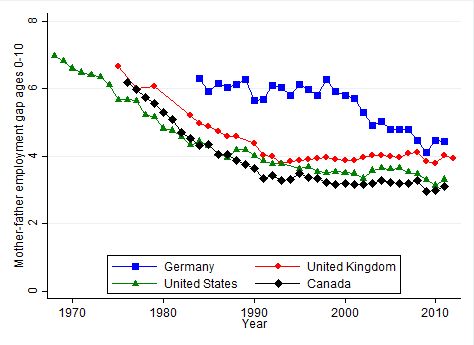In 1985, Nobel Laureate Gary Becker observed that the gap in employment between mothers and fathers of young children had been shrinking since the 1960s in OECD countries. This led Becker to predict that such sex differences “may only be a legacy of powerful forces from the past and may disappear or be greatly attenuated in the near future.” In the 1990s, however, the shrinking of the mother-father gap stalled before Becker’s prediction could be realized. In today’s economy, how big is this mother-father employment gap, what forces underlie it, and are there any policies which could close it further?
A simple way to characterize the mother-father employment gap is to sum up how much more work is done by mothers compared to fathers of children from ages 0 to 10. In 2010, fathers in the United States worked 3.1 more years on average than mothers over this age 0 to 10 age range. In the United Kingdom, the comparable number is 3.8, while in Canada it is 2.9 and Germany 4.5. The figure below traces the evolution of this mother-father employment gap for all four of these countries.

Becker’s theorizing about the family can help us to understand the development of this mother-father employment gap. Becker’s theoretical models suggest that if there are even slight differences between the productivity of mothers and fathers in the home vs. the workplace, spouses will tend to specialize completely in either in-home or in out-of-home work. These kind of productivity differences could arise because of cultural conditioning, as society pushes certain roles and expectations on women and men. Also, biology could be important as women have a heavier physical burden during pregnancy and after the birth of a child women have an advantage in breastfeeding. It is possible that the initial impact of these unique biological roles for mothers lingers as their children age. Biology is not destiny, but should be acknowledged as a potential barrier that contributes to the origins of the mother-father work gap.
Will today’s differences in mother-father work patterns persist into the future? To some extent that may depend on how cultural attitudes evolve. But there’s also the possibility that family-friendly policy can move things along more quickly. Both parental leave and subsidized childcare are options to consider.
Analysis of some data across the four countries suggest that these kinds of policies can make some difference, but the impact is limited.
Parental leave makes a very big difference when the children are age zero and the parent is actually taking the leave—but because mothers take much more parental leave than fathers, this increases the mother-father employment gap rather than shrinking it. Evidence suggests that after age 0 when most parents return to work, there doesn’t seem to be any lasting impact of having taken a maternity leave on mothers’ employment patterns when their children are ages 1 to 10.
Another policy that might matter is childcare. In the Canadian province of Quebec, a subsidized childcare program was put in place in 1997 that required parents to pay only $5 per day for childcare. This program not only increased mothers’ work at pre-school ages, but also seems to have had a lasting impact when their children reach older ages, as employment of women in Quebec increased at all ages from 0 to 10. When summed up over these ages, Quebec’s subsidized childcare closed the mother-father employment gap by about half a year of work.
Gary Becker’s prediction about the disappearance of mother-father work gaps hasn’t come true – yet. Evidence from Canada, Germany, the United States, and the United Kingdom suggests that policy can contribute to a shrinking of the mother-father employment gap. However, the analysis makes clear that policy alone may not be enough to overcome the combination of strong cultural attitudes and any persistence of intrinsic biological differences between mothers and fathers.
Image credit: Hispanic mother with two children, © Spotmatik, via iStock Photo.
The post The road to egalitaria appeared first on OUPblog.


